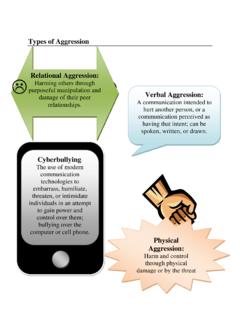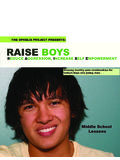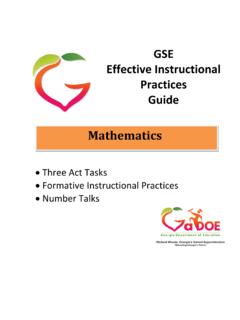Transcription of Practicing Interventions: Role Playing - Ophelia …
1 2012. The Ophelia Project. All rights reserved. Practicing interventions : Role Playing You cannot simply explain an intervention technique to students and expect them to use it. They need practice these skills using multiple scenarios, before we can expect them to actually apply what they know in real life. A well-directed role play can be a challenging and powerful learning experience. Role plays provide opportunities for participants to explore different situations, gain insight, identify problems, resolve conflicts, and create solutions.
2 Students experience and identify with characters and roles that simple discussions cannot. As the participants go into the role play and put their energy in developing and portraying realistic characters, they begin to experience what each character is feeling and experiencing as they play it through. In Practicing multiple solutions to a single situation, students gain comfort in the upstander strategies that they feel would work best for them, and have more than one resource for dealing with aggression. 2012. The Ophelia Project. All rights reserved.
3 Creating a Role Play Role play is an excellent way of making the experience of others real; if awareness about bullying is raised, a no-bullying culture is encouraged. Keith Sullivan, The Anti-Bullying Handbook Step One: Prepare the Role Play Decide ahead of time the purpose or goals of the role play and keep the topic age appropriate. In order to develop empathy, research shows that it is more effective if a participant with a predominant role steps into the shoes of another role. ( the aggressor assumes the role of the target in particular role plays) Avoid having participants role play aggression whenever possible.
4 Instead, start the role play after the aggressive act has taken place or have the facilitator play the role of the aggressor. Step Two: Prepare the Role Players Explain the purpose of role play and what the role players will be doing. Stress that the role play is a way to allow them to generate solutions to a problem or explore unfamiliar situations. Explain that the purpose it to be educational, experimental, fun, informative, intentional, and practical. Assign roles to participants (or ask for volunteers). Clearly state each person s character and the role in aggression. Step Three: Prepare the Audience Remind the audience to be attentive to behaviors.
5 They will be asked to provide feedback. It may be helpful to assign specific audience members key elements to look for (aggressor, target, bystander, upstander, non-verbal communication, signs of aggression, body language, making it right, etc.) Choose elements that match the goals of the role play. If participants are not quite sure of what is expected the facilitator should provide guidance and demonstration. Step Four: Present the Role Play Have participants perform the role play for the audience. Consider presenting multiple options based on the same premise. 2012. The Ophelia Project.
6 All rights reserved. Processing the Role Play Processing a role play provides the participants the opportunity to discuss how it felt and what they were thinking while in the various roles . This is the time where youth draw meaning from the role play experience and make connections to their own lives. Here are some suggested processing questions: When role Playing aggressive acts: describe each role in aggression (target, aggressor, and bystander) and determine the roles of characters in the role play. Ask the following questions while participants answer in character : o Aggressor: How did you feel?
7 (Powerful, popular, threatened, ashamed, etc.) o Target: How did you feel? (Sad, scared, excluded, confused, frustrated, helpless, etc.) o Bystanders: What was going on with you? How were you feeling? (embarrassed, stuck, scared, silent, frustrated, guilty, disappointed in myself, alone, etc.) Have audience members report their observations. Discuss alternate options or outcomes and how these could be achieved. Seek realistic solutions to the problem within the role play. Participants should try out a few of the suggestions followed by processing each idea. How did that feel? Is that a realistic solution?
8 Etc. Discuss the moral or lesson to be learned from presenting the role play. What is expected for the participants and audience to take away from this experience? 2012. The Ophelia Project. All rights reserved. Role Plays and Story Starters Teasing vs. Taunting One student makes fun of your best friend, but always says, Just kidding after every mean comment. When you make a mistake on a group project, another student calls you stupid. A student trips in the hallway and everyone laughs and calls her clumsy. A student who always raises her hand in class is called teacher s pet after school.
9 A group of students always makes fun of a heavier student in the class. One student makes fun of another student in front of the whole class. Everyone laughs. Touching vs. Hitting Every time Joey does not get his way, he punches the person who upset him. The student sitting behind you pokes you repeatedly with her pencil during class. An older student in the cafeteria always pulls your friend s long ponytail when he walks by your table. You witness a fist fight on the playground. Your friends always high five to celebrate victory in physical education class. Casey high fives so hard it hurts.
10 Friendship Groups vs. Cliques and Good Popular vs. Bad Popular A new student walks in the door halfway through the school year. He does not know anyone. You do not play on the school s basketball team, but you would still like to play basketball with the other children at recess. They tell you that you are not allowed because you are not on the team. In choosing teams for a game on the playground or in physical education class, people begin arguing about which team will have to take a player who is less skilled and is not friends with many people.















